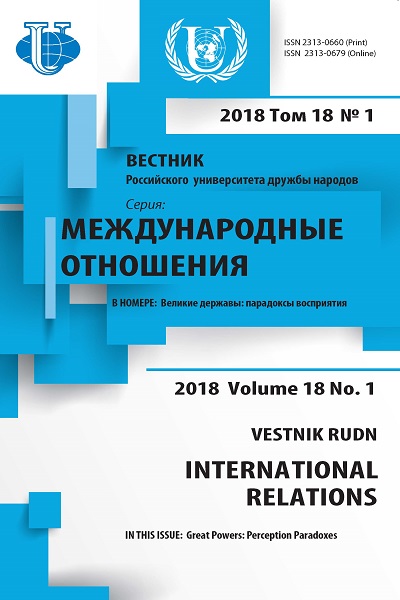Iran and Saudi Arabia in the Middle East: leadership and sectarianism (2011-2017)
- Authors: Diansaei B.1
-
Affiliations:
- RUDN University (Peoples’ Friendship University of Russia)
- Issue: Vol 18, No 1 (2018): Great Powers: Perception Paradoxes
- Pages: 124-134
- Section: PEACE AND SECURITY
- URL: https://journals.rudn.ru/international-relations/article/view/18381
- DOI: https://doi.org/10.22363/2313-0660-2018-18-1-124-134
Cite item
Full Text
Abstract
Relations between Iran and Saudi Arabia have never been at a desirable level. Iran’s 1979 revolution, the fall of Saddam Hussein in Iraq and the Arab Spring in turn increased the disagreement between the two regional powers. This article examines the relationship between Iran and Saudi Arabia in the Middle East between 2011 and 2017. Both countries claim to have leadership over other Islamic Muslim countries in the Middle East, in which Iran as a Shia state and Saudi Arabia as a Sunni-Wahhabi state have multiple ideological and political conflicts that have drawn opposing interests for each other. As a result, new multifactor regional international situation involving Iran and Saudi Arabia arose, to analyze which it would make sense to apply the general scientific analytical methods (logical, typological, inductive-deductive methods, etc.), and a number of specific methods for direct study of international relations, including those based on a systemic approach. The author examines the two powerful Middle Eastern countries with an emphasis on instrumental sectarianism as an important component of the regional order transformation proсess, understanding Iran as one of the superior powers of the region in the context of Islamic discourse and the same role of Saudi Arabia with strong tendency in the framework of Arab discourse. It was concluded that Iran and Saudi Arabia have ambitions for a larger share of the new Middle East and from the viewpoint of religious perspective, are instrumental in expanding their influence in the Middle Eastern countries.
About the authors
Behzad Diansaei
RUDN University (Peoples’ Friendship University of Russia)
Email: behzaddiansaee@gmail.com
postgraduate student of the Department of Theory and History of International Relations of the RUDN University
References
- Al-Smadi, Fatima. (2017). Iran and the Arab Revolutions: Narratives Establishing Iran’s Monopolism. 18 March 2017. URL: http://studies.aljazeera.net/en/reports/2017/03/iran-arab-revolutions-narratives-establishing-irans-monopolism-170318050125225.html (accessed: 22.12.2017)
- Borujerdi, A.H. (2016). Development of Arab-Iranian relations. Tehran: Publishing house of Ministry of Foreign Affairs
- El-Labbad, M. (2014). Egypt: A Regional Reference in the Middle East. In: Regional Powers in the Middle East: New Constellations after the Arab Revolts. Ed. by H. Furtig. New York: Palgrave, p. 81-91
- Esfandiary, D. & Tabatabai, A. (2016). Yemen: An Opportunity for Iran-Saudi Dialogue? The Washington Quarterly, 39 (2), 155-174. DOI: https://doi.org/10.1080/0163660X.2016.1204415
- Filipkova, L., Hesova, Z., Karasek, T., Kubikova, N., Kuzvart, J. & Zahora, J. (2012). NATO and the Arab Spring: challenge to cooperation, Opportunity for Action? Association for International Affairs. URL: https://www.amo.cz/wp-content/uploads/2015/11/pp-2012-01.pdf (accessed: 10.09.2017)
- Firas, Abu Hilal. (2011). Iran and the Arab Revolutions: positions and Repercussions. Arab Center for Research and Policy Studies. Doha. URL: https://www.dohainstitute.org/en/lists/ACRPS-PDFDocumentLibrary/Iran_and_the_Arab_Revolutions_Positions_and_Repercussions.pdf (accessed: 04.04.2016)
- Gause, G. (2011). Is Saudi Arabia really counter-revolutionary? The Middle East channel. Foreign policy. URL: http://foreignpolicy.com/2011/08/09/is-saudi-arabia-really-counter-revolutionary/ (accessed: 16.03.2017).
- Gause, G.F. (2014). Beyond Sectarianism: The New Middle East Cold War. Brookings Doha Center. URL: https://www.brookings.edu/wp-content/uploads/2016/06/English-PDF-1.pdf (accessed: 12.03.2017).
- Gause, G. (2015). The Future of U.S - Saudi Relations: The Kingdom and the Power. Foreign Affairs, 95(4). URL: https://www.foreignaffairs.com/articles/united-states/2016-06-13/future-us-saudi-relations (accessed: 16.03.2017).
- Goodarzi, J.M. (2013). Syria and Iran: Alliance Cooperation in a Changing Regional Environment. Middle East Studies, 4 (2), 31-59.
- Hinnebusch, R. (2014). The Arab Uprisings and The MENA Regional States System. Uluslararasi iliskiler-International relations, 11(42), 7-27.
- Hinnebusch, R.A. (2016). The Sectarian Revolution in the Middle East. R/Evolutions: Global Trends & Regional Issues, 4(1), 120-152.
- Keynoush, Banafshe. (2016). Saudi Arabia and Iran: Friends or Foes? London: Pallgrave and Macmillan.
- Khoury, N.A. (2013). The Arab Cold War Revisited: The Regional Impact of the Arab Uprising. Middle East Policy, 20 (2), 73-87.
- Kurzman, C. (2012). The Arab Spring: Ideals of the Iranian Green Movement, Methods of the Iranian Revolution. International Journal of Middle East Studies, 44(1), 162-165. DOI: https://doi.org/ 10.1017/S0020743811001346.
- Mabon, S. (2012). The Battle for Bahrain: Iranian-Saudi Rivalry. East Policy, 19(2), 84-97. doi: 10.1111/j.1475-4967.2012.00537.x.
- Malt Zahn, N.V. (2015). The Syria-Iran Axis: Cultural Diplomacy and International Relations in the Middle East (Library of Modern Middle East Studies). London, New York: I.B. Tauris & Co Ltd.
- Matthiesen, T. (2015). Transnational Identities after the Arab Uprising. In: The Gulf Monarchies beyond the Arab spring: changes and challenges. Ed. by L. Narbone & M. Lestra. Florence: European University Institute, p. 32-36. doi: 10.2870/930212.
- Mohseni, P. (2015). Iran and the Arab World after the Nuclear Deal: Rivalry and Engagement in a New Era. Belfer Center for Science and International Affairs. URL: https://www.belfercenter.org/ sites/default/files/legacy/files/Impact%20on%20Arab%20World%20-%20Web.pdf (accessed: 22.08.2017).
- Narbone, L. & Lestra, M. (2015). The Gulf Monarchies beyond the Arab spring: changes and challenges. Florence: European University Institute. doi: 10.2870/930212 URL: http://cadmus.eui.eu/ handle/1814/37734 (accessed: 12.08. 2016).
- O’Bagy, E. (2013). The free Syrian Army. Institute for the Study of War. URL: http://www.understandingwar.org/report/free-syrian-army (accessed: 06.09. 2017).
- Rosen, N. (2010). Aftermath. Following the Bloodshed of America’s wars in the Middle East. N.Y.: Nation books.
- Schmierer, R., Jeffrey, J. F., Nader, A. & Nazer, F. (2016). The Saudi-Iranian Rivalry and the Obama Doctrine. Middle East policy, 23(2), 5-30.
- Shaw, M. (2009). Sociological approaches to international relations. URL: https://www.eolss.net/ sample-chapters/C14/E1-35-01-07.pdf (accessed: 12.08. 2016).
- Thiel, T. (2012). After the Arab Spring power shift in Middle East? Yemen’s Arab Spring: from youth revolution to fragile political transition. LSE Research Online. London School of Economics and Political Science. URL: http://eprints.lse.ac.uk/43465/1/After%20the%20Arab% 20Spring_Yemen%E2%80%99s%20Arab%20Spring%28lsero%29.pdf (accessed: 02.09.2017)
- Ulrichsen, K.C. (2015). The Uprising in Bahrain: Regional Dimensions and International Consequences. In: Routledge Handbook of the Arab Spring: Rethinking Democratization. Ed. by Labra Sadiki. New York: Routledge Taylor & Francis Group, p. 133-144











